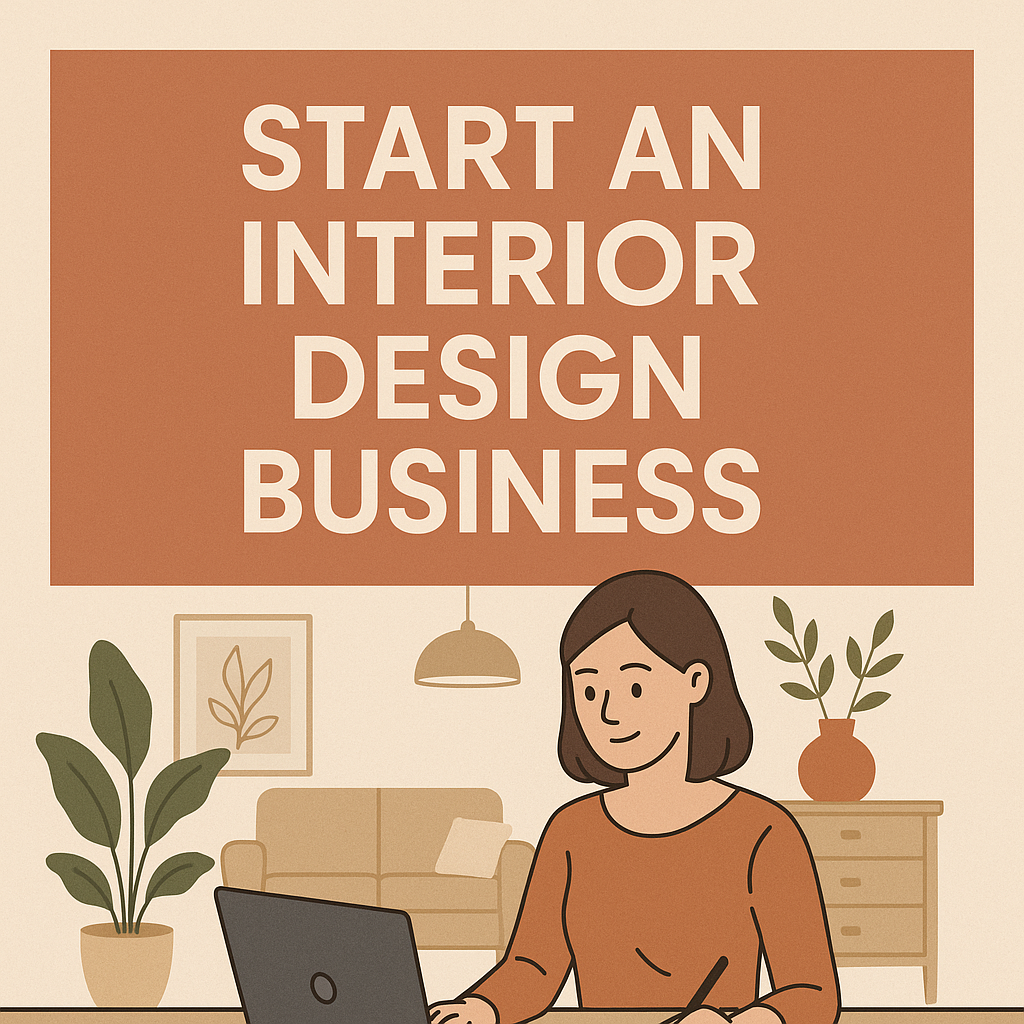Turning creative vision into a profitable venture requires more than a good eye for color and texture. The interior design industry thrives on balancing artistry with smart business strategies, offering endless opportunities for those ready to build their own path. This guide unlocks proven methods to launch and grow a practice that reflects your unique style while attracting loyal clients.
Successful entrepreneurs prove formal credentials aren’t mandatory for success. One designer grew a seven-figure firm while juggling parenting and a corporate career—no prior clients or industry connections. Their story demonstrates what’s possible with strategic planning and persistence.
You’ll learn to craft a standout brand, set competitive rates, and streamline operations. We’ll explore client outreach techniques that work in today’s digital landscape and share actionable steps to avoid common pitfalls. While creativity fuels this field, sustainable growth demands business fundamentals tailored to design professionals.
Key Takeaways
- Industry experience isn’t required—many top designers launched without formal training
- Strategic branding separates thriving practices from competitors
- Client relationships drive repeat business and referrals
- Pricing models must balance profitability with market expectations
- Digital tools simplify project management and marketing efforts
Introduction to Your Interior Design Journey
Creating beautiful spaces isn’t just about aesthetics—it’s about building meaningful client relationships. This career path offers creative freedom paired with real-world problem-solving, where every project becomes a chance to impact how people live and work. Whether refreshing homes or reimagining offices, your vision shapes environments that tell stories.
Overview of What to Expect
The field thrives on balancing artistry with practical business decisions. You’ll manage budgets, source materials, and collaborate with contractors—all while maintaining your unique style. Many find the mix of hands-on creativity and strategic planning keeps the work dynamic and fulfilling.
| Benefits | Opportunities | Growth Areas |
|---|---|---|
| Emotional satisfaction from transformed spaces | Residential remodels & commercial contracts | Sustainable design practices |
| Flexible project selection | Specialized niches like aging-in-place solutions | Smart home integrations |
Why Interior Design Stands Out
Clients increasingly value professionals who blend functionality with beauty. A well-designed room can boost productivity in workplaces or create sanctuary-like homes. As one industry report notes: “Spaces that resonate emotionally lead to 73% higher client referral rates.”
Financial rewards grow alongside your reputation. Entry-level designers often charge $50-$150 hourly, while established firms command 15-30% of total project costs. The key? Delivering memorable results that keep clients coming back.
Understanding the Interior Design Industry
Spaces that adapt to modern lifestyles drive today’s interior design industry. Clients now seek solutions merging beauty with purpose, from eco-conscious materials to tech-enhanced living areas. This shift creates fresh market openings for forward-thinking professionals.
Current Trends and Market Opportunities
Sustainable practices dominate client requests. Over 68% of homeowners prefer recycled or low-carbon materials, according to recent design industry surveys. Wellness-focused layouts—think circadian lighting or air-purifying plants—also gain traction as health awareness grows.
Smart home integrations offer another revenue stream. Designers skilled in blending voice-controlled systems with aesthetic elements stand out. Virtual reality tools let clients “walk through” concepts before installation, reducing revisions and boosting satisfaction.
Social media reshapes client discovery. Platforms like Instagram spotlight portfolios, while AI-powered apps match interior designers with local projects. One firm doubled bookings using TikTok tutorials showing quick room makeovers.
Regulations vary widely across states. While no federal licensing exists, some cities require permits for commercial work. Always verify local rules before accepting contracts. The market rewards those who combine technical savvy with timeless style.
Defining Your Interior Design Services
Your service menu acts as the foundation for client relationships and revenue streams. Craft offerings that showcase expertise while solving specific problems homeowners or businesses face. A boutique studio owner increased bookings 40% by narrowing their focus to multifunctional small-space solutions—a pressing need in urban markets.
Choosing Specializations and Offerings
Specializing creates clarity. Residential clients often seek experts in kitchens, while commercial projects demand knowledge of ADA compliance. Consider these popular options:
- Full-service packages handling everything from concept to installation
- Virtual consultations for budget-conscious clients
- Color psychology sessions to transform room moods
Hybrid models work well too. One designer combines in-person space planning with digital mood boards, allowing clients to visualize projects before committing.
Aligning Services With Your Strengths
Audit your technical skills and creative passions. Love sourcing vintage pieces? Build a design services tier around curated antique integration. Strong with CAD software? Offer detailed 3D renderings as standalone products.
| Strengths | Service Ideas |
|---|---|
| Material sourcing | Custom furniture packages |
| Lighting design | Ambiance optimization plans |
Partner with contractors if needed. A Florida-based pro expanded into outdoor kitchens by collaborating with landscape architects—a smart way to grow services without new certifications.
-
If you’re mapping out an operational structure, this guide to the six primary business functions offers clarity on how to allocate responsibilities effectively.
How to Start an Interior Design Business
Transforming creative passion into a thriving practice demands both vision and methodical execution. A structured approach helps navigate the exciting yet complex journey from concept to client projects. Focus on these essential phases to establish credibility and momentum.
Roadmap for New Ventures
Begin with market analysis. Identify local demand gaps—maybe eco-friendly kitchens or home offices dominate requests. One designer landed 12 clients in 3 months by targeting suburban ADU conversions. Next, outline your:
- Service tiers (full-room makeovers vs. hourly consultations)
- Revenue streams (product commissions, virtual workshops)
- Operational needs (project management software, vendor accounts)
| Phase | Timeline | Key Actions |
|---|---|---|
| Foundation | 2-4 weeks | Competitor analysis, pricing models, budget allocation |
| Legal Setup | 1-2 weeks | Business registration, insurance policies, contract templates |
| Brand Launch | 3-5 weeks | Portfolio curation, website development, social media strategy |
Allocate time for skill development. Online courses on 3D rendering or sustainable materials can elevate your offerings. As industry leader Melissa Lee advises: “Invest in tools that make clients’ decision-making effortless—like augmented reality room previews.”
Track progress with quarterly milestones. Adjust strategies based on early client feedback—perhaps virtual consultations outperform in-person meetings. Stay agile while maintaining your core brand promise.
Identifying Your Personal Style and Niche
Clients don’t hire a decorator—they invest in a perspective that aligns with theirs. Your style becomes the filter through which you solve spatial challenges, making intentional choices crucial for attracting ideal projects.
Finding Your Unique Design Voice
Start by cataloging influences. What colors, textures, or layouts consistently appear in your mood boards? One designer discovered their signature through childhood memories of Mediterranean courtyards, blending terracotta tones with modern minimalism.
Popular niches showing growth include:
- Biophilic designs connecting spaces to nature
- Multigenerational home adaptations
- Tech-forward workspaces
| Approach | Client Appeal |
|---|---|
| Modern Farmhouse | Families seeking cozy yet sleek environments |
| Urban Eclectic | Young professionals wanting bold, mixed-material statements |
Validate your direction through local market research. A Chicago-based interior designer tested three niches via Instagram polls before specializing in pet-friendly luxury homes—now their fastest-growing service.
Curate a portfolio showing range within your specialty. Feature before/after transformations that highlight problem-solving skills. As design coach Lara Simmons notes: “Your best clients recognize themselves in your past work.”
Strategic Business Planning and Market Research
Every thriving practice begins with data-driven decisions. Your business plan acts as both compass and roadmap, guiding choices while attracting partners or investors. Start by mapping local demand—are urban professionals seeking home offices? Do families want kid-friendly luxury? Answering these questions shapes your path to sustainable success.
Understanding Your Target Audience
Create detailed buyer personas. A Portland designer discovered 68% of their clients were remote workers needing ergonomic solutions—a goldmine for tailored services. Consider these factors:
- Income brackets and spending habits
- Preferred communication channels (email vs. social media)
- Pain points like tight timelines or budget constraints
Market research tools simplify trend spotting. Google Trends reveals surging searches for “biophilic bedrooms,” while surveys uncover material preferences. One firm used Instagram polls to refine their service tiers, boosting bookings by 40%.
Competitor Analysis and Positioning
Study rivals like a detective. What gaps exist in their offerings? A Texas studio carved a niche by providing 3D renderings upfront—a service competitors charged extra for. Track:
| Competitor Strength | Your Opportunity |
|---|---|
| Premium pricing | Mid-range packages with quick turnaround |
| Limited virtual services | Expanded digital consultations |
Positioning statements clarify your edge. “Transforming cramped apartments into functional art” immediately tells potential clients what you deliver. Update your plan quarterly using fresh market data—consumer needs evolve faster than ever.
“Your first-year financial projections should account for three scenarios: best-case, realistic, and survival mode.”
Choosing and Registering a Business Name
Your company’s identity begins with three powerful elements: memorability, relevance, and distinctiveness. A well-chosen name acts as your first handshake with clients, conveying style before they see your portfolio. Consider these essentials when brainstorming:
- Reflect core values through rhythm and word choice (“LuxeNest” vs “ModernVibe”)
- Test pronunciation with friends—names should roll off the tongue effortlessly
- Check domain availability early (Namechk.com scans 150+ platforms)
Legal protection comes next. Conduct thorough searches through your state’s business registry and USPTO database. A New York studio avoided costly rebranding by discovering “ChromaSpace” was trademarked in their county. Secure these three components:
| Requirement | Purpose |
|---|---|
| Fictitious Name Certificate | Operate under non-legal names |
| Federal Trademark | Nationwide brand protection |
| Local Permits | Compliance with municipal regulations |
Structure decisions impact taxes and liability. Sole proprietorships offer simplicity, while LLCs shield personal assets. Consult local agencies about industry-specific licenses—some states require additional certifications for commercial projects.
Final pro tip: Reserve social media handles matching your website URL. Consistency across platforms builds recognition. As branding expert Tasha Cole notes: “Your name isn’t just a label—it’s the opening chapter of your success story.”
Building Your Brand Identity and Online Presence
Your brand tells a story before you speak. It’s the visual handshake that introduces your style and values to potential clients. A cohesive identity builds trust and makes your work instantly recognizable across platforms.
Creating a Memorable Logo and Visuals
Colors and typography become your silent ambassadors. Warm earth tones might signal organic minimalism, while bold geometric shapes suggest modern edge. One studio increased inquiries by 55% after switching to a logo featuring adaptable patterns reflecting their modular design approach.
Consistency matters across all touchpoints:
- Use matching fonts in proposals and social media graphics
- Develop a signature color palette for mood boards
- Create templates for client presentations
Developing a Professional Website
Think of your website as a 24/7 showroom. Mobile responsiveness isn’t optional—62% of users browse portfolios on phones first. Include these essentials:
- Fast-loading project galleries with before/after sliders
- Clear service descriptions with pricing hints
- Contact forms linked to your project management software
Optimize for local searches. A Seattle designer ranks #1 for “luxury kitchen remodels” by embedding neighborhood names in website metadata. Integrate Instagram feeds to showcase real-time work.
Social media amplifies your reach when used strategically. Post time-lapse videos of installations on Instagram Reels, or share Pinterest boards highlighting emerging trends. One firm gained 2,000 followers in a month by hosting weekly Q&As about sustainable materials.
“Your online presence should mirror the care you put into physical spaces—every pixel matters.”
Creating a Winning Portfolio
Your portfolio acts as a visual handshake with potential clients. It’s where creativity meets proof of skill, transforming abstract ideas into tangible results. Even without completed projects, strategic presentation of concept designs builds trust and sparks interest.
Showcasing Past and Concept Projects
New designers often worry about limited work history. Solve this by photographing your own home spaces or crafting digital renderings. One pro landed their first commercial contract using 3D kitchen concepts modeled after trending Airbnb layouts.
Include diverse formats to demonstrate range. Mood boards reveal your color mastery, while before/after sliders highlight problem-solving abilities. Update your portfolio quarterly—replace concept pieces with real projects as you complete them.
Presentation matters as much as content. Use high-resolution images and concise captions explaining your choices. Organize work by room type or style to help clients envision their home transformations. As digital portfolios gain traction, consider adding video walkthroughs of your best projects.
Remember: every piece should reflect your design signature. A cohesive portfolio attracts clients who resonate with your aesthetic, turning viewers into collaborators.







